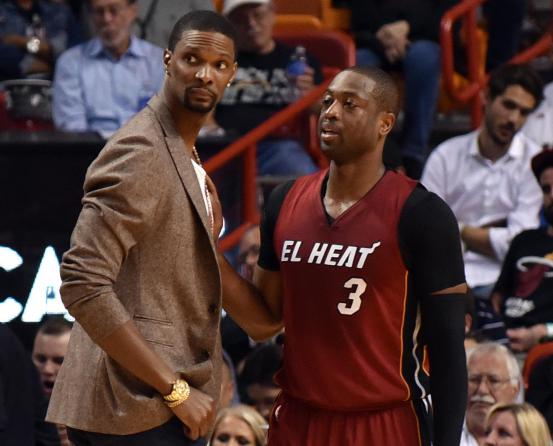- Commissioner’s statement on Ventura, Marte
- Ronnie O’Sullivan: Masters champion ‘felt so vulnerable’ in final
- Arron Fletcher Wins 2017 WSOP International Circuit Marrakech Main Event ($140,224)
- Smith challenges Warner to go big in India
- Moncada No. 1 on MLB Pipeline’s Top 10 2B Prospects list
- Braves land 2 on MLB Pipeline’s Top 10 2B Prospects list
- Kingery makes MLB Pipeline’s Top 10 2B Prospects list
- New Zealand wrap up 2-0 after Bangladesh implosion
- Mathews, Pradeep, Gunathilaka to return to Sri Lanka
- Elliott hopes for rain for Poli
How Chris Bosh’s Absence Has Impacted, and Will Continue to Impact, Miami Heat
- Updated: May 7, 2016

MIAMI — An otherwise unassuming date on the 2015-16 NBA calendar proved to be a season savior for the resilient Miami Heat.
It was Feb. 19, and they had a road stop against the Atlanta Hawks. When the Heat took the floor, they were without leading scorers Chris Bosh (blood clots) and Dwyane Wade (knee soreness), plus intimidating defensive anchor Hassan Whiteside (suspended).
But the short-handed Heat flashed two traits that have since come to define them: fight in the face of adversity and a high-octane offense. They not only secured a 115-111 win, they also found the blueprint for many victories to come.
“We had to adjust and figure out who was going to score and how we were going to do that,” Goran Dragic later told Bleacher Report. “I think that was the moment we decided to run more.”
The Heat haven’t let off the accelerator since. Despite missing their heaviest hitter, Bosh, who’s officially out for the postseason, they’re now trading punches with and have stolen home-court advantage from the East’s second-seeded Toronto Raptors.
Miami’s systematic overhaul is equal parts a testament to this group’s flexibility, one of this season’s biggest what-if questions, and an interesting wrinkle in what will be a fascinating offseason for this organization.
How It Happened
There have been massive personnel changes, both internal and external. Injuries shut down both Bosh and Beno Udrih, who was bought out after having season-ending foot surgery. Trades sent out the likes of Mario Chalmers, Chris Andersen and Jarnell Stokes.
The only significant external addition was seven-time All-Star Joe Johnson, who joined the Heat after being bought out by the Brooklyn Nets. But the rotation expanded to include rookie second-rounder Josh Richardson, who’s added pesky defense and perimeter shooting.
Miami’s revamped offensive attack also made Dragic and Luol Deng look like different players. With Dragic given a neon-green light and Deng repurposed as a small-ball power forward, the pair elevated both their production and the impact of it.
Collectively, the two went from averaging 22.8 points on 45.1 percent shooting before the break to 32.5 on 48.5 after. The offense exploded around them, though it’s sputtered a bit in the playoffs.
Create column charts
After following the lead of Wade and Bosh to start the season, Miami had to uncover an alternative when that option was no longer available.
“The train doesn’t wait for you,” Heat coach Erik Spoelstra said. “You have to keep on getting out there and competing. You have to find other ways.”
What the Heat found was an uptempo, egalitarian attack. They had two players average more than 13 points before the break: Bosh and Wade. After intermission, that number jumped to five: Wade, Dragic, Deng, Johnson and Whiteside.
But within that equal-opportunity system, the Heat still have a structured hierarchy.
Dragic and Deng are the offensive energizers.
Deng seamlessly shifts between corner-spacing and off-ball cutting roles, and he’s bailed the Heat out more than a few times on …
continue reading in source www.bleacherreport.com
